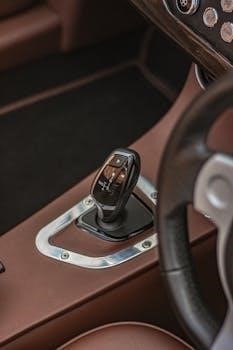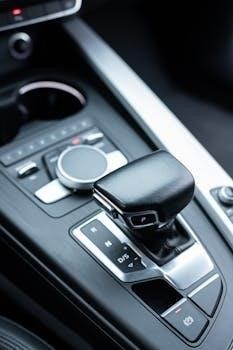Parking Brake in Manual Transmission Vehicles⁚ A Comprehensive Guide
Parking a manual transmission vehicle requires understanding the relationship between the parking brake and gear selection. Correct techniques, especially on inclines, secure the vehicle, ensure safety and prevent unexpected rolling. This guide explains best practices for manual transmission vehicles.
In the realm of driving, particularly with manual transmissions, the parking brake is more than just an auxiliary system; it’s a vital safety component. Often referred to as the handbrake or emergency brake, its primary role is to securely immobilize the vehicle when parked. Unlike automatic transmissions that have a “Park” setting, manual cars rely heavily on the parking brake to prevent movement. This is especially critical on inclines where gravity can cause a parked car to roll.
Understanding how to properly engage and maintain the parking brake in a manual transmission vehicle is essential for all drivers. It ensures the safety of the vehicle, its occupants, and others nearby. Moreover, the parking brake can also serve as a backup braking system in emergencies if the primary brakes fail. Different types of parking brake systems exist, from manual levers and pedals to modern electronic versions, each with its operational nuances.
This comprehensive guide delves into the specifics of parking brakes in manual transmissions, covering their importance, correct usage, maintenance, and legal considerations. Whether you’re a seasoned manual driver or just starting out, mastering the use of the parking brake is a crucial aspect of responsible vehicle operation.
Why Use a Parking Brake with a Manual Transmission?
Using a parking brake with a manual transmission is essential for safety and security. Unlike automatic cars with a “Park” mode, manuals rely on the parking brake to stay stationary. Without it, the car could roll, especially on slopes, causing accidents or damage. The parking brake acts as a crucial backup, preventing movement even if the car is left in gear.

It’s also vital for maintaining the health of your transmission. Over time, relying solely on the transmission to hold the car can strain its components, leading to costly repairs. The parking brake alleviates this stress, distributing the load more evenly. Regular use ensures the parking brake remains functional, ready for emergencies.
Moreover, many regions have legal requirements for using the parking brake when parked, emphasizing its role in responsible vehicle operation. Ignoring this can lead to fines or legal repercussions; Employing the parking brake consistently is a simple yet effective habit that enhances safety, protects your vehicle, and keeps you compliant with the law. It’s a practice every manual transmission driver should embrace.
Correct Parking Procedure on Level Ground
Parking a manual transmission vehicle on level ground still requires a specific procedure to ensure safety. First, bring the car to a complete stop using the regular brake pedal. Once stopped, engage the parking brake firmly. This action prevents any unexpected movement of the vehicle. Next, shift the gear lever into first gear or reverse. The gear you select is less crucial on level ground compared to inclines, but it still provides an extra layer of security.
After shifting into gear, turn off the engine. Before releasing the brake pedal, double-check that the parking brake is firmly engaged and the car is stable. Slowly release the brake pedal, allowing the car’s weight to rest on both the transmission and the parking brake. This distributes the load and minimizes stress on any single component.
Finally, ensure the steering wheel is straight to avoid any potential rolling if the parking brake were to fail. While level ground presents minimal risk, consistently following this procedure establishes good habits. Remember to check your vehicle’s owner’s manual for specific recommendations.
Parking Uphill with a Manual Transmission
Parking uphill with a manual transmission demands extra care to prevent the vehicle from rolling downhill. First, signal your intention to park and pull over to the curb as safely as possible. Once stopped, engage the parking brake firmly before doing anything else. This is your primary defense against gravity.
Next, shift the transmission into first gear. This ensures that the engine’s resistance acts as a secondary barrier against rolling. After shifting into gear, turn the steering wheel sharply away from the curb. If, despite your best efforts, the car begins to roll downhill, the turned wheels will guide it towards the curb, hopefully stopping it from entering traffic.
Turn off the engine and remove the key from the ignition. Before exiting the vehicle, double-check that the parking brake is fully engaged and the gear lever is securely in first. As a final precaution, consider placing a wheel chock behind the rear wheel on the downhill side for added security, especially on steep inclines; Consistent use of these steps ensures safety and prevents potential accidents.
Parking Downhill with a Manual Transmission
Parking downhill with a manual transmission requires a specific set of procedures to ensure the vehicle remains safely stationary. Begin by signaling your intent to park and carefully pulling over to the side of the road. Once stopped, fully engage the parking brake; this is crucial as it will bear the brunt of holding the car’s weight.
Next, shift the manual transmission into reverse gear. This utilizes the engine’s compression as a secondary form of resistance, preventing the wheels from freely rotating forward. Then, turn the steering wheel sharply towards the curb; in the event that the car begins to roll, the front tires will make contact with the curb, acting as a physical barrier to prevent the vehicle from rolling into traffic.

Turn off the engine and remove the keys from the ignition. Always double-check that the parking brake is engaged firmly and the gear lever is securely in reverse. For added safety, especially on steeper declines, use a wheel chock placed in front of the front tire on the downhill side; Regular adherence to these steps minimizes the risk of vehicle rollaway.
The Parking Brake as an Emergency Brake
While primarily intended for parking, the parking brake can serve as a crucial emergency brake in situations where the primary braking system fails. This secondary system operates independently, offering a vital backup to bring the vehicle to a halt. In a manual transmission car, this can be particularly useful, allowing the driver to maintain some control even when faced with a sudden loss of hydraulic brakes.
However, it’s important to understand the limitations. The parking brake typically applies force only to the rear wheels, which can lead to reduced stopping power and potential for rear-wheel lockup, especially at higher speeds. This can cause the vehicle to become unstable or even skid. Therefore, using the parking brake as an emergency brake requires careful modulation.
Apply it gradually and evenly, avoiding sudden jerks. Downshifting through the gears can help slow the vehicle while using the parking brake. If the primary brakes fail, pump the brake pedal to see if you can restore some braking force. Steer carefully and be prepared to release the parking brake momentarily if the rear wheels lock up to regain control of the vehicle. Always prioritize safety and consider it a backup option.
Types of Manual Parking Brakes
Manual parking brakes come in several mechanical designs, each employing distinct mechanisms to engage the rear brakes and hold the vehicle stationary. The most common types include manual lever, pedal-type, and, increasingly, electronic parking brakes, even in manual transmission vehicles.
The manual lever parking brake, typically located between the front seats, utilizes a hand-operated lever connected to the rear brakes via cables. Pulling the lever applies tension to the cables, engaging the brakes. The degree of braking force is controlled by how far the lever is pulled, offering a tactile feel for brake engagement.
Pedal-type parking brakes, usually positioned to the left of the driver’s foot pedals, are engaged by pressing down on a pedal. A ratcheting mechanism holds the pedal in place, maintaining brake pressure. To release it, a separate release handle or lever is used. While less common now, they were widely used in older vehicles.
Manual Lever Parking Brakes
The manual lever parking brake, often referred to as a handbrake, is a mechanically operated system commonly found in manual transmission vehicles. Positioned between the front seats, it consists of a lever connected to the rear brakes through a series of cables. This design offers drivers a direct, tactile method for applying the parking brake.
When the lever is pulled, tension is applied to the brake cables, which in turn activates the rear brakes. The amount of force applied to the brakes is directly proportional to how far the lever is pulled. This allows for precise control, enabling drivers to adjust the braking force based on the slope and load of the vehicle. A ratchet mechanism typically holds the lever in the engaged position, maintaining constant pressure on the brakes.
To release the manual lever parking brake, a button or trigger on the lever is depressed, disengaging the ratchet and allowing the lever to return to its disengaged position. This releases the tension on the cables, deactivating the rear brakes. Regular maintenance is essential to ensure proper function.
Pedal-Type Parking Brakes
Pedal-type parking brakes, another mechanical system, offer a different approach to engaging the parking brake. Instead of a hand-operated lever, this system utilizes a foot pedal, typically located to the left of the clutch pedal. Drivers engage the parking brake by pressing the pedal down with their foot.
Similar to the lever-type, the pedal-type system uses cables to connect the pedal to the rear brakes. When the pedal is pressed, the cables tighten, applying braking force to the rear wheels. A ratcheting mechanism holds the pedal in the engaged position, maintaining consistent braking pressure.
Releasing the pedal-type parking brake usually involves a separate release handle or lever, often positioned near the dashboard or under the steering wheel. Pulling this handle disengages the ratcheting mechanism, allowing the pedal to return to its original position and releasing the brakes. Though less common than lever-type systems, pedal-type parking brakes provide a viable alternative, particularly in vehicles where space is a concern. Regular inspection and maintenance are crucial for optimal performance.

Electronic Parking Brakes in Manual Transmissions
Electronic parking brakes (EPB) are increasingly common, even in manual transmission vehicles. Unlike traditional lever or pedal systems, EPBs use an electronic control unit and actuators to engage and disengage the parking brake. The driver activates the system via a button or switch, signaling the control unit to apply the brakes.
The electronic control unit then commands electric motors or actuators to tighten the brake cables or directly apply pressure to the brake pads or shoes. Sensors monitor the braking force, ensuring consistent and reliable performance. EPBs often offer additional features such as automatic engagement when the vehicle is turned off or disengaged when the driver accelerates. In manual transmissions, EPBs can provide added convenience and safety, especially on hills.

However, it’s important to understand how the EPB interacts with the manual transmission to prevent stalling or rollback. Regular maintenance, including software updates and brake inspections, is essential to ensure the EPB functions correctly and maintains optimal braking performance.
Common Parking Brake Problems and Maintenance
Parking brakes, whether manual or electronic, can experience problems that compromise their effectiveness. Common issues include cable stretching, corrosion, and worn brake shoes or pads. Cable stretching reduces the braking force applied to the wheels, requiring adjustment or replacement.
Corrosion can seize the cables or mechanisms, preventing proper engagement or disengagement. Worn brake shoes or pads diminish the parking brake’s ability to hold the vehicle, particularly on inclines. Electronic parking brakes can encounter sensor malfunctions, actuator failures, or software glitches.
Regular maintenance is crucial to prevent and address these issues. Inspect the parking brake cables for fraying, corrosion, and proper tension. Adjust the cable tension as needed, following the manufacturer’s recommendations. Replace worn brake shoes or pads promptly. For electronic parking brakes, ensure the system receives software updates and diagnose any error codes. Periodically test the parking brake’s holding ability on an incline to verify its effectiveness. Addressing problems early prevents more extensive damage and maintains safety.
Legal Requirements and Safe Parking Practices
In many regions, using the parking brake is a legal requirement, emphasizing its importance in responsible vehicle operation. Laws often mandate using the parking brake when parking on inclines or in areas where the vehicle could pose a hazard. Failure to comply can result in fines or liability in case of an accident.
Beyond legal obligations, safe parking practices are essential for preventing accidents and protecting property. Always engage the parking brake fully when parking a manual transmission vehicle, regardless of the terrain. Supplement this by leaving the vehicle in gear – first gear when parking uphill and reverse when parking downhill.
Curbing the wheels when parking on an incline adds an extra layer of security. Turn the wheels towards the curb when facing downhill and away from the curb when facing uphill. Regularly inspect and maintain the parking brake to ensure it functions correctly. Remember, the parking brake is a vital safety device, and its proper use is a fundamental aspect of responsible driving.
